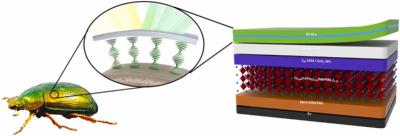Researchers from Kyung Hee University and Ulsan National Institute of Science and Technology (UNIST) in Korea have used cholesteric reflective screens, which were influenced by the skin of a beetle, to produce efficient and opaque perovskite solar cells. Unlike metal and oxide-based reflection screens, cholesteric reflective filters (ChRFs) are entirely composed of organic compounds and are much easier to design and implement.

For use in colored perovskite solar cells (PSCs), two distinct kinds of ChRFs were produced, each with a distinct cross-linking pattern (monolayer or bilayer). Since the color of the ChRFs varies depending on the angle of view, they can be utilized to make colored PSCs. As the reflective screens were created using only organic components and wet procedures, they can be used to build large and adaptable PSCs without the need for expensive suction methods.
To replicate the spiral organization seen in the beetle's skin, the researchers used a liquid crystalline cholesteric arrangement.
The reflective spectra, frequency, and absorbance of the developed ChRFs were more easily manipulated than those of metallic oxide reflective screens. Furthermore, since ChRFs are made of organic components using wet procedures, they are not constrained by the form and size of the hardware used.
Two distinct kinds of ChRFs were created for use in colored PeSCs. ChRF1 PSCs demonstrated negligible PCE losses (10%) but had a limited color range due to the filter's 50% reflectivity.
By comparison, ChRF2 PSCs displayed larger PCE losses because their reflectance was double that of the ChRF1 PeSCs. However, the increased aesthetic qualities of ChRF2 PSCs owing to the broader color spectrum compensate for the reduced PCE, notably in BIPV applications.
This research presented the development of the first colored perovskite solar cells using ChRFs, influenced by the skin of a beetle. The colorful PSCs reported in this study are designed for use on roofs and building walls to maximize solar energy collection while retaining architectural aesthetics.



